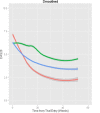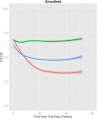Novel methodology to discern predictors of remission and patterns of disease activity over time using rheumatoid arthritis clinical trials data
- PMID: 30487994
- PMCID: PMC6241979
- DOI: 10.1136/rmdopen-2018-000721
Novel methodology to discern predictors of remission and patterns of disease activity over time using rheumatoid arthritis clinical trials data
Abstract
Objectives: To identify predictors of remission and disease activity patterns in patients with rheumatoid arthritis (RA) using individual participant data (IPD) from clinical trials.
Methods: Phase II and III clinical trials completed between 2002 and 2012 were identified by systematic literature review and contact with UK market authorisation holders. Anonymised baseline and follow-up IPD from non-biological arms were amalgamated. Multiple imputation was used to handle missing outcome and covariate information. Random effects logistic regression was used to identify predictors of remission, measured by the Disease Activity Score 28 (DAS28) at 6 months. Novel latent class mixed models characterised DAS28 over time.
Results: IPD of 3290 participants from 18 trials were included. Of these participants, 92% received methotrexate (MTX). Remission rates were estimated at 8.4%(95%CI 7.4%to9.5%) overall, 17%(95%CI 14.8%to19.4%) for MTX-naïve patients with early RA and 3.2% (95% CI 2.4% to 4.3%) for those with prior MTX exposure at entry. In prior MTX-exposed patients, lower baseline DAS28 and MTX reinitiation were associated with remission. In MTX-naïve patients, being young, white, male, with better functional and mental health, lower baseline DAS28 and receiving concomitant glucocorticoids were associated with remission. Three DAS28 trajectory subpopulations were identified in MTX-naïve and MTX-exposed patients. A number of variables were associated with subpopulation membership and DAS28 levels within subpopulations.
Conclusions: Predictors of remission differed between MTX-naïve and prior MTX-exposed patients at entry. Latent class mixed models supported differential non-biological therapy response, with three distinct trajectories observed in both MTX-naïve and MTX-exposed patients. Findings should be useful when designing future RA trials and interpreting results of biomarker studies.
Keywords: DAS28 trajectories; latent class mixed models; methotrexate; randomised controlled trial; remission; rheumatoid arthritis.
Conflict of interest statement
Competing interests: Although the UK RA-MAP Consortium is the author, there are a number of individuals (ie, contributors) to this paper, some of whom may have competing interests through their industry affiliation, research funding or consultancy activities. We have uploaded a file listing the contributors and their competing interests if any in the online supplementary material 1.
Figures


References
Grants and funding
LinkOut - more resources
Full Text Sources
Molecular Biology Databases
